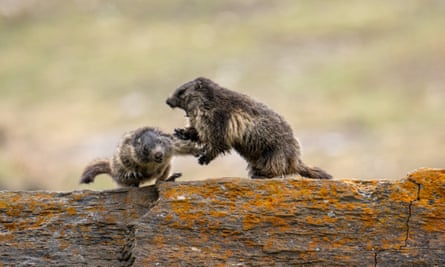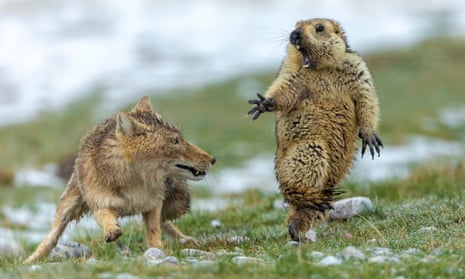The ecologist Christophe Bonenfant strides down the mountainside, a metal cage strapped to his back. Inside, a hessian bag twitches and squirms. His cargo is 4kg of befuddled alpine marmot, a mountain rodent admired by hikers, immortalised by Goethe and Beethoven, and the star of a beloved French ad for Milka chocolate.
The creatures’ cuddly reputation, however, belies a vicious reality. The life of an alpine marmot is a never-ending bloody battle for dominance. They are, Bonenfant’s colleague Rébecca Garcia says, “mega-violent”. And now the climate crisis is making their fight for survival in the Alps more deadly than ever.

In a tiny lab set inside a mountain chalet near the French-Italian border, Garcia, the site’s technician, waits for Bonenfant and his seething charge. It is a sweltering summer day down at sea level, but 2,400m up the snow is still shin-deep in places and fog rolls through the valley, periodically obscuring the Aiguille de la Grande Sassière peak.
Together, Garcia and Bonenfant have 30 minutes to bring the marmot down from the mountain, anaesthetise it, measure it, take samples of blood, hair and droppings, revive it and return it to the site where it was captured – all while avoiding a set of teeth capable of severing a human finger. The clock is ticking: a marmot can lose its territory in less than an hour.
When they finish, the marmot will return to its place in a cycle of what Bonenfant calls “despotic reproduction”. The rodents live in family groups with one dominant couple and a clutch of subordinate offspring who help with raising young and providing much-needed body warmth during the long winter hibernation.

Only the dominant pair may reproduce: they bully the other family members into sterility, the youngsters’ stress hormones maintained at too high a level to bear young of their own. If a subordinate of either sex wishes to reproduce, they must leave their family group and challenge another dominant marmot for its territory – or kill their parents.
When a marmot wins the battle for new territory, its first act is mass infanticide. “The new dominant will kill off that year’s young so as not to have to look after them – no investment, no parenting for young that are not his own,” Bonenfant says.
The team calls this war for dominance “Game of Burrows”, referencing the interfamilial backstabbing and vicious power struggles of a certain prestige television show. Out on patrol, Garcia points out a far-flung territory where a brother and sister shacked up and established a new dynasty last year. “We called them the Lannisters,” she says.
Data collected from La Grande Sassière by scientists at the Université de Lyon since the project began in 1990 has provided much of what we know today about the alpine marmot and its despotic ways. It has also revealed that the rapidly warming climate of the Alps is making each season of the game of burrows more bloodthirsty than the last. Conflicts are increasing, and subordinates are leaving their family groups earlier, leading to more fights for dominance.

In the age of global heating, marmots are suffering from the same scourge as the nearby ski resorts: not enough snow. Families rely on a thick layer to insulate their burrows, where they spend half the year in hibernation. As snow cover gets thinner, the burrows get colder, making marmot pups less likely to survive the winter, even with their family’s body warmth to help them. Today, baby marmots are as likely to die in large family groups as the young of a single dominant couple, Bonenfant says. That means there are fewer incentives for subordinates to remain loyal.
“They’ll take their chances directly rather than staying in the family group,” he says. “The consequences are that we see social structures and family groups which are less stable over time.”
The rise in changeovers in dominant couples leads to increased infanticides of the marmot pups that do survive the winter. Females are producing smaller litters, which researchers also attribute to the climate crisis. While marmots are not classed as endangered, the cycle is causing the population to steadily drop by 4% a year, Bonenfant says.
Other climate-related changes act as threat multipliers for the rodents. Marmots require wide-open prairie spaces to alert their family members to the threat of approaching predators. As the Alps warm, the treeline is stalking higher up the mountainside, shrinking their territory. Meanwhile, new predators like foxes are moving in.

The Alps are warming at a faster rate than much of the planet, and provide some of the starkest images of the climate emergency: glaciers are retreating and rockfaces are cracking and tumbling after years of persistent drought. In 2022, lack of snow, extreme heat and an influx of Saharan dust combined to fuel the largest loss of glacial ice ever recorded in the European Alps.
If the Alps are the climate sentinels of Europe, marmots are one of the sentinels of the Alps, demonstrating how a species with a complex social structure can see its life quickly transform as a result of human-induced global heating. Its life is becoming more nasty, brutish and short.
At La Grande Sassière laboratory, the scientists’ examination of their charge is done, and he is left to come to his senses in the chalet toilet. He must be fully alert, Garcia says, by the time he is returned to his territory on the alpine slopes.
Gradually, the rodent wakes. Garcia secures him in the backpack cage and sets out across the valley, crossing a mountain stream and ascending to the small patch of prairie the creature is charged with defending.
Garcia opens the cage, unties the sack and the fully conscious marmot dashes up into his Alpine domain. His next battle awaits.
Find more age of extinction coverage here, and follow biodiversity reporters Phoebe Weston and Patrick Greenfield on X (formerly known as Twitter) for all the latest news and features
